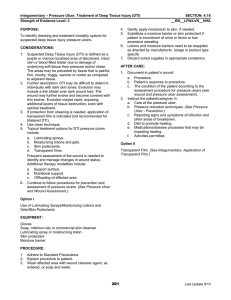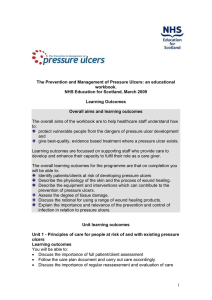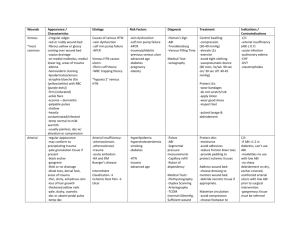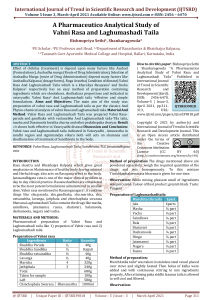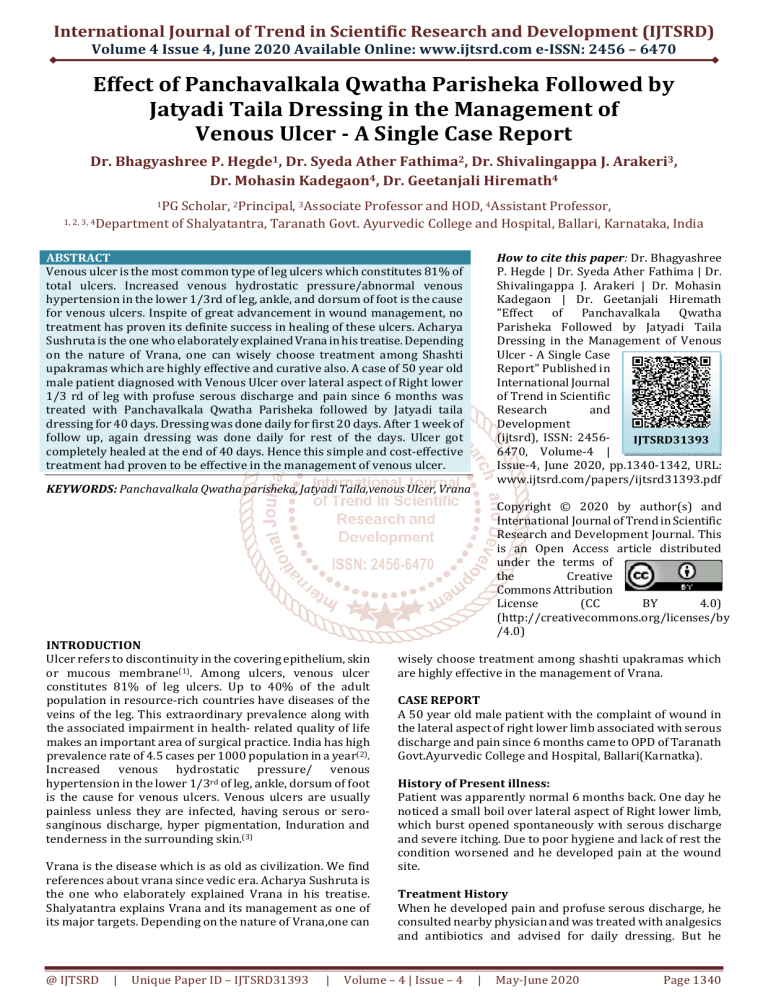
International Journal of Trend in Scientific Research and Development (IJTSRD)
Volume 4 Issue 4, June 2020 Available Online: www.ijtsrd.com e-ISSN: 2456 – 6470
Effect of Panchavalkala Qwatha Parisheka Followed by
Jatyadi Taila Dressing in the Management of
Venous Ulcer - A Single Case Report
Dr. Bhagyashree P. Hegde1, Dr. Syeda Ather Fathima2, Dr. Shivalingappa J. Arakeri3,
Dr. Mohasin Kadegaon4, Dr. Geetanjali Hiremath4
1PG
Scholar, 2Principal, 3Associate Professor and HOD, 4Assistant Professor,
1, 2, 3, 4Department of Shalyatantra, Taranath Govt. Ayurvedic College and Hospital, Ballari, Karnataka, India
ABSTRACT
Venous ulcer is the most common type of leg ulcers which constitutes 81% of
total ulcers. Increased venous hydrostatic pressure/abnormal venous
hypertension in the lower 1/3rd of leg, ankle, and dorsum of foot is the cause
for venous ulcers. Inspite of great advancement in wound management, no
treatment has proven its definite success in healing of these ulcers. Acharya
Sushruta is the one who elaborately explained Vrana in his treatise. Depending
on the nature of Vrana, one can wisely choose treatment among Shashti
upakramas which are highly effective and curative also. A case of 50 year old
male patient diagnosed with Venous Ulcer over lateral aspect of Right lower
1/3 rd of leg with profuse serous discharge and pain since 6 months was
treated with Panchavalkala Qwatha Parisheka followed by Jatyadi taila
dressing for 40 days. Dressing was done daily for first 20 days. After 1 week of
follow up, again dressing was done daily for rest of the days. Ulcer got
completely healed at the end of 40 days. Hence this simple and cost-effective
treatment had proven to be effective in the management of venous ulcer.
How to cite this paper: Dr. Bhagyashree
P. Hegde | Dr. Syeda Ather Fathima | Dr.
Shivalingappa J. Arakeri | Dr. Mohasin
Kadegaon | Dr. Geetanjali Hiremath
"Effect of Panchavalkala Qwatha
Parisheka Followed by Jatyadi Taila
Dressing in the Management of Venous
Ulcer - A Single Case
Report" Published in
International Journal
of Trend in Scientific
Research
and
Development
(ijtsrd), ISSN: 2456IJTSRD31393
6470, Volume-4 |
Issue-4, June 2020, pp.1340-1342, URL:
www.ijtsrd.com/papers/ijtsrd31393.pdf
KEYWORDS: Panchavalkala Qwatha parisheka, Jatyadi Taila,venous Ulcer, Vrana
Copyright © 2020 by author(s) and
International Journal of Trend in Scientific
Research and Development Journal. This
is an Open Access article distributed
under the terms of
the
Creative
Commons Attribution
License
(CC
BY
4.0)
(http://creativecommons.org/licenses/by
/4.0)
INTRODUCTION
Ulcer refers to discontinuity in the covering epithelium, skin
or mucous membrane(1). Among ulcers, venous ulcer
constitutes 81% of leg ulcers. Up to 40% of the adult
population in resource-rich countries have diseases of the
veins of the leg. This extraordinary prevalence along with
the associated impairment in health- related quality of life
makes an important area of surgical practice. India has high
prevalence rate of 4.5 cases per 1000 population in a year(2).
Increased venous hydrostatic pressure/ venous
hypertension in the lower 1/3rd of leg, ankle, dorsum of foot
is the cause for venous ulcers. Venous ulcers are usually
painless unless they are infected, having serous or serosanginous discharge, hyper pigmentation, Induration and
tenderness in the surrounding skin.(3)
Vrana is the disease which is as old as civilization. We find
references about vrana since vedic era. Acharya Sushruta is
the one who elaborately explained Vrana in his treatise.
Shalyatantra explains Vrana and its management as one of
its major targets. Depending on the nature of Vrana,one can
@ IJTSRD
|
Unique Paper ID – IJTSRD31393
|
wisely choose treatment among shashti upakramas which
are highly effective in the management of Vrana.
CASE REPORT
A 50 year old male patient with the complaint of wound in
the lateral aspect of right lower limb associated with serous
discharge and pain since 6 months came to OPD of Taranath
Govt.Ayurvedic College and Hospital, Ballari(Karnatka).
History of Present illness:
Patient was apparently normal 6 months back. One day he
noticed a small boil over lateral aspect of Right lower limb,
which burst opened spontaneously with serous discharge
and severe itching. Due to poor hygiene and lack of rest the
condition worsened and he developed pain at the wound
site.
Treatment History
When he developed pain and profuse serous discharge, he
consulted nearby physician and was treated with analgesics
and antibiotics and advised for daily dressing. But he
Volume – 4 | Issue – 4
|
May-June 2020
Page 1340
International Journal of Trend in Scientific Research and Development (IJTSRD) @ www.ijtsrd.com eISSN: 2456-6470
neglected the condition and discontinued the treatment due
to economical issue. Hence he consulted TGAMCH for further
management.
Personal history
Appetite-Good
Bowel-Once/day
Micturition-4-5 times/day
Sleep-Disturbed due to pain
Habit- Tobacco chewing since 20 years, Smoking since 10
years left one year back.
This methodology was done daily for 20 days. After 7 days of
follow up again dressing was done daily for rest of the days.
RESULTS
The ulcer got healed completely after 40 days of treatment
leaving behind a scar. Patient got relief from pain and
itching.
Occupational History
He is a coolie worker and works for 8-10 hours/day.
General Exmination
Built-Moderate
Vitals
Pallor-Absent
P.R.-76bpm
Icterus-Absent
B.P.-130/80 mmHg
Clubbing- Absent
Temperature-98.6 F
Cyanosis- Absent
H.R.-76 bpm
Lymphadenopathy- Absent
R.R-18 cycles/min
Edema- Absent
Systemic ExaminationCVS-S1S2 heard, no added sounds
RS-Chest Bilaterally Symmetrical, NVBS heard
CNS-Conscious, well oriented
P/A- Soft, Non tender, no palpable mass.
Before treatment on 11/11/2019
Local Examination of UlcerInspectionSite-lower 1/3rd of Right limb,5 cm above lateral malleolus
Size-4cmx6cmx1/2 mm
Shape-Irregular
Floor-Pinkish Granulation tissue with slight slough
Edge-sloping
Discharge-Serous
Surrounding area-Black Pigmentation with dry scales
During Treatment on 5/12/2019
PalpationTemperature-Not raised
Tenderness- Slightly present at the margin
Pulsations- Dorsalis Pedis Artery:Palpable
Posterior Tibial Artery:Palpable
Margin- Tender,Indurated.
InvestigationsHb%-11.3gm%
WBC-6,500/ml
ESR-20mm in 1st hour
Diagnosis-Venous Ulcer
After Treatment on 20/12/2019
Treatment PlannedOral MedicationManjishtadi kashaya 15ml TID
T. Amratadi guggulu 1 TID
T. Saptamrita Loha 1BD
External ApplicationInitially wound was cleaned with Normal Saline thoroughly.
Kashaya was prepared from Panchavalkala Qwatha choorna
and Parisheka was done in its warm state for 5 minutes.
Mode of Action
Panchavalkala-Nyagrodha, Udumbara, Ashwattha, Plaksha,
Pareesha
Dressing was done with Jatydi Taila.
@ IJTSRD
|
Unique Paper ID – IJTSRD31393
DISCUSSION
Sushruta while explaining Parisheka, tells that it pacifies
pain just like water pacifies fire afflicted house(4). Depending
on the involvement of doshas the drugs are selected for
Parisheka. In Vata dosha involvement, kashaya prepared out
of Sarpi,taila,Mamsarasa and Vatahara oushadha is used. In
Pitta dosha involvement ksheera, ghrita, madhu, sharkara,
ksheerivruksha kashaya are used. In Kaphaja variety
taila,mutra,ksharodaka are used.
|
Volume – 4 | Issue – 4
|
May-June 2020
Page 1341
International Journal of Trend in Scientific Research and Development (IJTSRD) @ www.ijtsrd.com eISSN: 2456-6470
Panchavalkala
Guru
Kashaya Rasa
Sheeta Veerya
Rooksha and
Kashaya Guna
Sthambaka
and Grahi
Kaphahara,Lekh
aneeya,Rakta
shodhaka
Decreases Vata
Pacifies Ruja
Reduces
Discharge
Reduces kandu,
Srava and helps in
debridement
Composition
Pharmacological
Action
Action on wound
Tannins (Vata,Udumbara)
Anti-oxidants,
Antiinflammatory
a) They prevent oxidation process which delays wound healing
and thus protect tissue from damage.
b)Help to increase Collagen
c)Help in wound contraction and increase Capillary formation.
Flavanoids (Vata, Pareesha,
Plaksha, Ashwattha)
Phytosterols
Anti-oxidants,
anti-inflammatory
Antiinflammatory
Prevent Prolongation of initial space
Prevent prolongation of initial phase, Help in wound
contraction and increase Capillary formation.
Action Of Jatyadi taila
Jatyadi Taila is already proven best Vrana shodhaka(6) .
Composition of Jatyadi Taila
Flavanoids,Glycosides,Tannins,Essential oils,steroids
Help in wound healing.
In vivo experiment of Jatyadi Taila shows significant increase in Protein, Hydroxyproline and Hexosamine content in the
granulation tissue.
CONCLUSION
Venous Ulcers take longer duration for healing, sometimes
requiring surgical procedure for the management. We have
got many formulations for wound healing in our classics, but
their effectiveness have to be proved by adopting them
depending upon the condition. In present scenario wound
management is difficult because of its prolong duration of
healing. Simplification in the management ,cost effectiveness
and reduction in the duration of the treatment are the need
of the hour .Panchavalkala Qwatha Choorna and Jatyadi Taila
are such kind of medicines which are easily available and
cost-effective which have shown their significant results
within minimal duration of time.
REFERENCES
[1] Das. A Concise Textbook Of Surgery.9th Edition.2014,
Chapter 11, 157pp.
[2] https//www.ncbi.nlm.nih.gov.>articles
@ IJTSRD
|
Unique Paper ID – IJTSRD31393
|
[3] S. Das. Concise text book
Edition.2014.Chapter 16, 261pp.
of
Surgery.
9th
[4] Acharya Sushruta. Sushruta Samhita. (Nibhanda
Sangraha commentary of Dalhanacharya& Nyaya
Panjika commentary of Gayadasa). Edited by Yadavji
Trikamji.1sted., Varanasi: Chaukamba Sanskrit
Samsthana 2014.Chikitsa sthana,1 st Chapter, Verse 18,
399pp
[5] Acharya Bhavamishra. Bhava Prakasha.Edited by Prof.
K. R. Srikantha Murthy. Varanasi: Chaukamba Sanskrit
Samsthana 2008. Volume 1, Poorva Khanda, 6th
Chapter, Verse 15,16,17,18, 295pp.
[6] Shri Govind Das sen.Bhaishajya Ratnavali(Vidyotini
Teeka of kaviraj Shri Ambikadatta Shastri). Edited by
Rajeshwar Datta shastri. 20th ed. Varanasi: Chaukamba
Sanskrit Samsthana 2010, 47th Chapter, Verse 64, 65,
66, 67, 851pp
Volume – 4 | Issue – 4
|
May-June 2020
Page 1342



